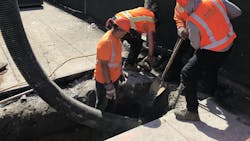Gateway Development Commission continues early work on Hudson Tunnel Project
The Gateway Development Commission is continuing preparation work for the Hudson Tunnel Project, which includes digging test pits on 30th Street in Manhattan, just east of 12th Avenue.
The site will be the northern boundary of a large ventilation shaft for the new Hudson River Tunnel. The preparatory work confirms the location of Con Edison cables feeding electricity into Manhattan and will ensure future construction of the ventilation shaft does not cut, damage or otherwise disturb these cables.
The board members of the commission said, “Digging a new rail tunnel connecting New York and New Jersey for the first time in over 110 years is an incredibly complex undertaking. This one action shows just how complex [this project is]. Even placing a portion of the 12th Avenue ventilation shaft requires knowing the whereabouts and relationships between interconnected infrastructure underground and ensuring nothing we do disrupts major functions like electricity to thousands of people. We are committed to putting the utmost care into every single project element that constitutes the Hudson Tunnel, because it must benefit the residents of this region and this nation.”
Combined with the ongoing geotechnical borings and subsurface investigations to better understand the underground conditions along the new Hudson River Tunnel’s future path and the work to relocate utilities from the path of the third section of the Hudson Yards Concrete Casing, the test pits demonstrate that the Hudson Tunnel Project continues moving forward in doing all the work possible to prepare for a fully funded project.
The early work on the Hudson Tunnel Project has resulted in, among other preparations, the full construction of the Hudson Yards Concrete Casing from 10th to 11th Avenues, a draft 30 percent design of the new Hudson River Tunnel and more than $1.4 billion in estimated construction cost savings due to reductions in risk and contingencies.
